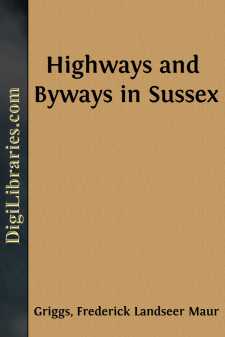Categories
- Antiques & Collectibles 13
- Architecture 36
- Art 48
- Bibles 22
- Biography & Autobiography 813
- Body, Mind & Spirit 142
- Business & Economics 28
- Children's Books 15
- Children's Fiction 12
- Computers 4
- Cooking 94
- Crafts & Hobbies 4
- Drama 346
- Education 46
- Family & Relationships 57
- Fiction 11829
- Games 19
- Gardening 17
- Health & Fitness 34
- History 1377
- House & Home 1
- Humor 147
- Juvenile Fiction 1873
- Juvenile Nonfiction 202
- Language Arts & Disciplines 88
- Law 16
- Literary Collections 686
- Literary Criticism 179
- Mathematics 13
- Medical 41
- Music 40
- Nature 179
- Non-Classifiable 1768
- Performing Arts 7
- Periodicals 1453
- Philosophy 64
- Photography 2
- Poetry 896
- Political Science 203
- Psychology 42
- Reference 154
- Religion 513
- Science 126
- Self-Help 84
- Social Science 81
- Sports & Recreation 34
- Study Aids 3
- Technology & Engineering 59
- Transportation 23
- Travel 463
- True Crime 29
Highways and Byways in Sussex
Description:
Excerpt
PREFACE
Readers who are acquainted with the earlier volumes of this series will not need to be told that they are less guide-books than appreciations of the districts with which they are concerned. In the pages that follow my aim has been to gather a Sussex bouquet rather than to present the facts which the more practical traveller requires.
The order of progress through the country has been determined largely by the lines of railway. I have thought it best to enter Sussex in the west at Midhurst, making that the first centre, and to zig-zag thence across to the east by way of Chichester, Arundel, Petworth, Horsham, Brighton (I name only the chief centres), Cuckfield, East Grinstead, Lewes, Eastbourne, Hailsham, Hastings, Rye, and Tunbridge Wells; leaving the county finally at Withyham, on the borders of Ashdown Forest. For the traveller in a carriage or on a bicycle this route is not the best; but for those who would explore it slowly on foot (and much of the more characteristic scenery of Sussex can be studied only in this way), with occasional assistance from the train, it is, I think, as good a scheme as any.
I do not suggest that it is necessary for the reader who travels through Sussex to take the same route: he would probably prefer to cover the county literally strip by strip—the Forest strip from Tunbridge Wells to Horsham, the Weald strip from Billingshurst to Burwash, the Downs strip from Racton to Beachy Head—rather than follow my course, north to south, and south to north, across the land. But the book is, I think, the gainer by these tangents, and certainly its author is happier, for they bring him again and again back to the Downs.
It is impossible at this date to write about Sussex, in accordance with the plan of the present series, without saying a great many things that others have said before, and without making use of the historians of the county. To the collections of the Sussex Archæological Society I am greatly indebted; also to Mr. J. G. Bishop's Peep into the Past, and to Mr. W. D. Parish's Dictionary of the Sussex Dialect. Many other works are mentioned in the text.
The history, archæology, and natural history of the county have been thoroughly treated by various writers; but there are, I have noticed, fewer books than there should be upon Sussex men and women. Carlyle's saying that every clergyman should write the history of his parish (which one might amend to the history of his parishioners) has borne too little fruit in our district; nor have lay observers arisen in any number to atone for the shortcoming. And yet Sussex must be as rich in good character, pure, quaint, shrewd, humorous or noble, as any other division of England. In the matter of honouring illustrious Sussex men and women, the late Mark Antony Lower played his part with The Worthies of Sussex, and Mr. Fleet with Glimpses of Our Sussex Ancestors; but the Sussex "Characters," where are they? Who has set down their "little unremembered acts," their eccentricities, their sterling southern tenacities? The Rev. A. D. Gordon wrote the history of Harting, and quite recently the Rev. C. N. Sutton has published his interesting Historical Notes of Withyham, Hartfield, and Ashdown Forest; and there may be other similar parish histories which I am forgetting. But the only books that I have seen which make a patient and sympathetic attempt to understand the people of Sussex are Mr. Parish's Dictionary, Mr. Egerton's Sussex Folk and Sussex Ways, and "John Halsham's" Idlehurst. How many rare qualities of head and heart must go unrecorded in rural England.
I have to thank my friend Mr. C. E. Clayton for his kindness in reading the proofs of this book and in suggesting additions.
E. V. L.
December 12, 1903.
P.S.—The sheets of the one-inch ordnance map of Sussex are fourteen in all, their numbers running thus:
300Alresford301
Haslemere302
Horsham303
T. Wells304
Tenterden316
Fareham317
Chichester318
Brighton319
Lewes320
Hastings331
Portsmouth332
Bognor333
Worthing334
Eastbourne
In the present edition a number of small errors have been corrected and a new amplifying certain points and supplying a deficit here and there has been added. The passage about Stane Street is reprinted from the Times Literary Supplement by kind permission....


